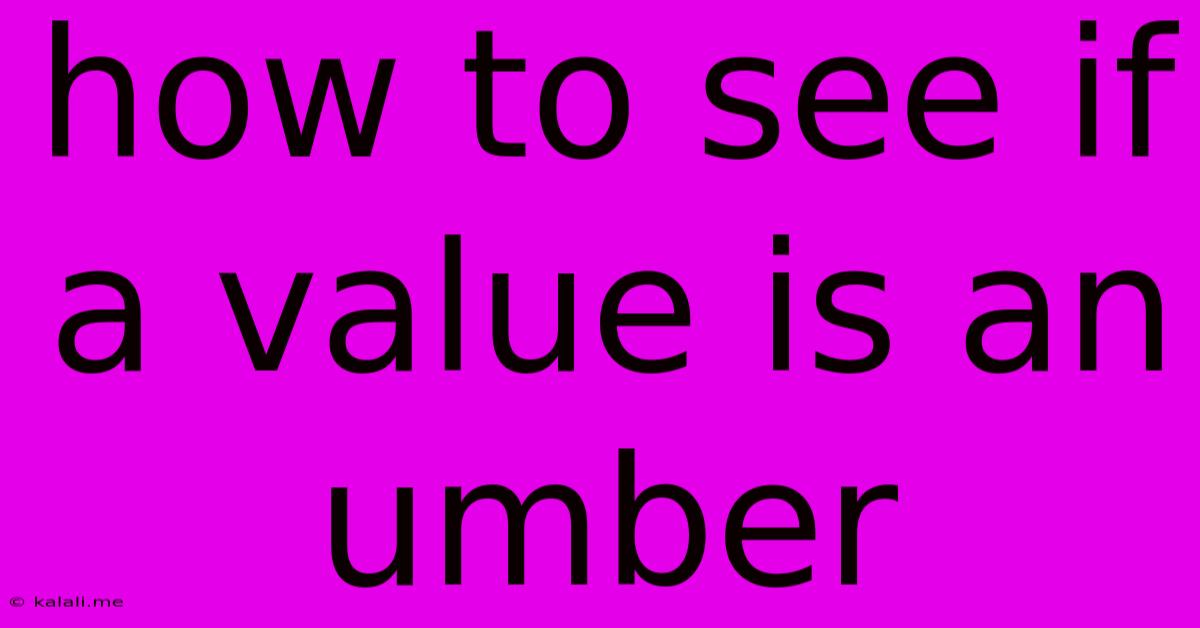How To See If A Value Is An Umber
Kalali
Jun 09, 2025 · 3 min read

Table of Contents
How to Check if a Value is a Number in Different Programming Languages
Determining whether a value represents a number is a fundamental task in programming. This seemingly simple check can become surprisingly nuanced depending on the programming language and the specific type of number you're dealing with (integer, floating-point, etc.). This article will guide you through effective methods for verifying numerical values across several popular programming languages. We'll cover techniques for handling integers, floating-point numbers, and even scenarios where you might encounter string representations of numbers.
Understanding Number Types
Before diving into the specifics of each language, let's clarify the different number types you might encounter:
- Integers: Whole numbers without decimal points (e.g., -2, 0, 10).
- Floating-point numbers (floats): Numbers with decimal points (e.g., -3.14, 0.0, 2.718).
- Complex numbers: Numbers with real and imaginary components (e.g., 2 + 3j in Python).
Methods for Checking Numerical Values
The approach to checking for numerical values varies significantly across programming languages. Here are some common techniques:
Python
Python offers several ways to check if a variable holds a numeric value:
isinstance()function: This is the most robust method for checking the type of a variable.
value = 10
if isinstance(value, (int, float, complex)):
print("The value is a number.")
else:
print("The value is not a number.")
value = "10"
if isinstance(value, (int, float, complex)):
print("The value is a number.") #This will print "The value is not a number."
else:
print("The value is not a number.")
type()function: This function returns the type of the variable. While functional,isinstance()is generally preferred for its ability to handle inheritance and multiple types.
value = 10.5
if type(value) in (int, float, complex):
print("The value is a number.")
- Exception Handling (for string conversion): If you expect a string representation of a number, you can use a
try-exceptblock to attempt conversion and catch potential errors:
value = "10.5"
try:
float(value)
print("The value is a number (string representation).")
except ValueError:
print("The value is not a number.")
JavaScript
JavaScript's typeof operator provides a simple way to check if a value is a number:
let value = 10;
if (typeof value === 'number') {
console.log("The value is a number.");
} else {
console.log("The value is not a number.");
}
let value2 = "10";
if (typeof value2 === 'number'){
console.log("The value is a number."); //This will print "The value is not a number."
} else {
console.log("The value is not a number.");
}
let value3 = 10.5;
if (typeof value3 === 'number'){
console.log("The value is a number.");
} else {
console.log("The value is not a number.");
}
Note that typeof NaN (Not a Number) also returns 'number', so additional checks might be necessary for specific scenarios involving NaN.
Java
Java uses the instanceof operator to check the type of an object:
int value = 10;
if (value instanceof Integer || value instanceof Double || value instanceof Float) {
System.out.println("The value is a number.");
} else {
System.out.println("The value is not a number.");
}
For string conversion, you can use the NumberFormatException to handle parsing errors:
String value = "10.5";
try {
Double.parseDouble(value);
System.out.println("The value is a number (string representation).");
} catch (NumberFormatException e) {
System.out.println("The value is not a number.");
}
Remember to import necessary classes like java.lang.Double and java.lang.Float if needed.
Conclusion
Verifying if a value is a number involves understanding the data types within your chosen programming language and employing appropriate techniques to handle various scenarios, including string representations of numbers. The methods outlined above provide a solid foundation for robust number validation in your programs. Remember to adapt these techniques based on the specific requirements of your application and the potential inputs you expect.
Latest Posts
Latest Posts
-
Car Ac Blows Air But Not Cold
Jun 09, 2025
-
How Long Can A Peanut Butter And Jelly Sandwich Last
Jun 09, 2025
-
How To Change Stats Rpg Maker Mv
Jun 09, 2025
-
Yellow Robot With Display For Face
Jun 09, 2025
-
Type Emojis In Mac Messenger Just Like Slack
Jun 09, 2025
Related Post
Thank you for visiting our website which covers about How To See If A Value Is An Umber . We hope the information provided has been useful to you. Feel free to contact us if you have any questions or need further assistance. See you next time and don't miss to bookmark.